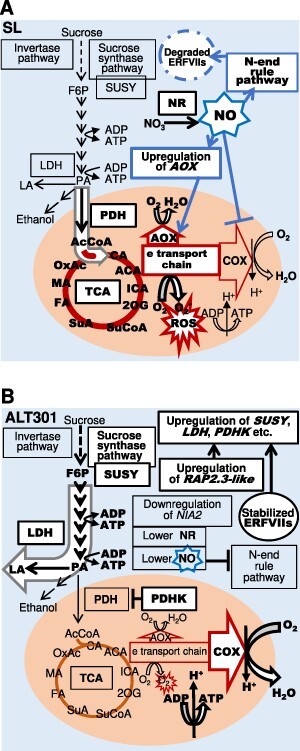Fig. 12.

Working hypothesis of central carbon metabolic pathways in SL (A) and ALT301 (B) and prevention mechanisms of ROS production in mitochondria in ALT301. Under normal growth condition, compared with SL (A), ALT301 (B) exhibits the downregulation of the NIA2 gene and the upregulation of the RAP2.3-like gene. Here, we assume that the lower NO level due to the downregulation of the NIA2 gene and resultant lower activity of NR stabilizes ERFVIIs including the RAP2.3-like protein. Then, the stabilized ERFVIIs activate a wide range of genes including hypoxia-responsive genes such as SUSY, LDH and PDHK, which leads to the enhancement of the SUSY pathway, the enhancement of lactate fermentation and the inhibition of PDH activity leading to the limitation of pyruvate entry into the TCA cycle, even under normoxia. On the other hand, NO is known to inhibit the oxygen consumption by COX and to activate AOX expression. These NO effects should be observed more extensively in SL, and it is likely that the imbalance between the electron supply from the TCA cycle and the electron consumption by COX on the electron transport chain enhances ROS production. Under this condition, in ALT301, the enhancement of aerobic fermentation reduces the electron supply form the TCA cycle, while lower NO level activate COX activity and reduce AOX activity. Thus, compared with SL, ALT301 seems to have a higher respiration rate and higher capacity to produce ATP with less generation of ROS. The events enhanced in either cell line (metabolism, gene expression, enzyme activity) are highlighted with a white background. The processes of activation and inhibition are indicated with an arrow and a line with a bar (⊥), respectively. The NO-mediated processes are indicated by blue lines.
